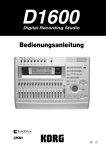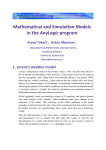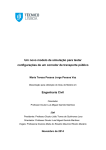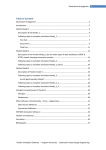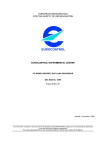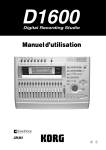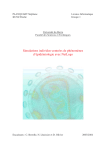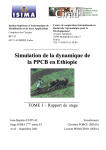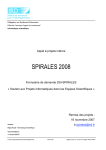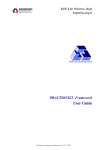Download Overview What is “a model”?
Transcript
Overview ● ● An Introduction to modeling social systems with Netlogo 1.1. Modeling methodology: physical, mathematical, and computational models 1.2. Agent Based Modeling (ABM): Overview, ABM & Social systems, ABM computer tools Laboratory for SocioHistorical Dynamics Simulation (LSDS-UAB) ● 1.3. Netlogo: download, installation, and first steps Training Program - Module 1 ● 1.4. Netlogo tools: library, dictionary and on-line resources Classroom activities: Downloading, Installing and Sampling NetLogo Models Library: Segregation, Life, Recycling, others. Update: February 2012 Individual activities: Netlogo testing: Models from Netlogo Library / Earth Science, and / Social Science. Reading: MACY, Michael W. & WILLER, Robert (2002) “From Factors to Actors: Computational Sociology and Agent-Based Modeling ”, Annual Review of Sociology, 28: 143-166 (doi: 10.1146/annurev.soc.28.110601.141117). 2/77 What is “a model”? An Introduction to modeling social systems with Netlogo ● ● 1.1. Modeling methodology: Physical, mathematical, and computational models 1.2. Agent Based Modeling (ABM): Overview, ABM & Social systems, ABM computer tools ● 1.3. Netlogo: download, installation, and first steps ● 1.4. Netlogo tools: library, dictionary and on-line resources 3/77 What is “modelling”? 4/77 Typology of models: Narrative An abstraction from real word phenomena, with explanatory aims. Narrative Models: Frequent in everyday life... ABSTRACTION EXPLANATORY Why it is that way? ...and in Social Sciences and Humanities Why it changes? How the whole process works? 5/77 6/77 Typology of models: Formal / Mathematical Typology of models: Physical Formal / Mathematical Models: Physical Models: Frequent in Physics Frequent in engineering research (e.g., Boyle's Law)... (e.g., testing “dummies”, birth simulators)... ...also present in Natural and Social Sciences (e.g., Lotka-Volterra population growth) ...also present in Social Sciences (e.g., Economy “water” simulators) 7/77 Typology of models: Physical SS.CC. 8/77 Typology of models: Physical SS.CC. Economy simulators (Irving Fisher, Bill Phillips) Physical Models in Social Sciences Economy simulators constructed by Irving Fisher, Monetary flux == Water flux 1893 1925 1925 1949 9/77 10/77 Typology of models: Computational Typology of models Computational Models: (Symbolic) Frequent in Engineering, Art and Entertainment.. INFORMATIONAL MODELS Narrative Formal Mathematical COMPUTATIONAL MODELS ENERGETIC MODELS (Material) ...also present in any other research domains. 11/77 Physical 12/77 Computational Models Computational Models: CODE Informational + Energetic CODE + DYNAMICS Rules + Interaction Outcomes Foundations + Emergence Model + Simulation The code of Th. Schelling's “Segregation” Netlogo Model 13/77 14/77 Computational Models: DYNAMICS Computational Models: DYNAMICS A quick example of simulation run: Schelling's “Segregation” Netlogo Model could be “played” online on your own browser, by accessing this URL: <http://ccl.northwestern.edu/netlogo/models/Segregation> ● Wait until your web browser runs your JAVA machine (if the computer does not have Java Runtime, the simulation could not work) ● ● Execution (run) of Th. Schelling's “Segregation” Netlogo Model Wait until your web browser downloads the Netlogo model. Set the number of people, and the % of “homophily”, or accept default values. ● Click on [ Setup ] button, to initialize the simulation (t=0) ● Click on [ Go ] button, to start the simulation. 15/77 Why use “qualitative” models? 16/77 Why use “quantitative” models? Narrative Models are: Formal models are: 1) Easy to understand (use to tell a story) 1) Difficult to understand (use formalisms) 2) Difficult to probe or falsify 2) Easy to probe or falsify 3) Words and relations not so precise (ambiguity): 3) Terms and Connectors are precise (NO ambiguity) ● Who much is “little”? ● How can you measure “influence”? 17/77 18/77 Why use “computational” models? Computation versus Simulation 1) Easy to understand (use to generate a story, or many) Computation: Find solutions to problems using computational techniques and / or algorithms for calculation of these solutions 2) More or less easy to probe or falsify 3) Terms and Connectors are precise (otherwise, simulation did NOT run) ● ● ● Display changes for one dimension / variable over time Display changes for one dimension / variable in space (e.g., GIS and dynamic mapping) ● Black box ● The final result is important ● The interest is in efficiency, convergence, and the correct solution => Some “simple” models, in equation system format, could be algebraically solved, BUT “extended” models are difficult to simulate without a lot of computability power. Changes over time and space, in a number of variables... u(x,y)=xy y=f(x) => Almost impossible to display or compute as an equation or equation system. => Can be displayed as outcome of algorithms recursively triggered qd(p)=qo(p) (x*,p*) 19/77 20/77 Computation versus Simulation Computation Vs. Simulation: A.C.E. Case Simulation: To study the behavior of a system by means of computational techniques that simulate the behavior of its components. ● Glass Box ● The whole process is important ● ● ● The interest lies in the complexity of the system, in the fitting of the simulations, in the regular patterns that appear ● ● ● ● (x*,p*) “Agent-Based Computational Economics” proposes a synthesis of Economic Analysis criticisms and a new method: computer simulation. ACE is a specialized application of “agent-based modelling” (a type of modelling). ACE is based on simulation of the economic behaviour for individual agents. ACE is based on a model of “man” with limited, or bounded, rationality (H. Simon, 1954). ACE is still a minority practice in Economics. ACE does not have to replace the standard economic analysis, but help to improve it and to complement it. Leigh Tesfatsion <http://www2.econ.iastate.edu/tesfatsi/ace.htm> 21/77 22/77 What can you do with models? Main uses of model simulation (Gilbert& Troitzsch, 2006) Reordered by aim of control Tool (expert systems) ● Building a model == “Theorization” ● ● Running / Executing == “Observation” ● Prediction (prospective scenarios) ● Validating a model == “Testing” / “Experimentation” ● Understanding (of real world phenomena) ● Using a model == “Prediction” / “Problem solving” ● MODEL run OUTCOME build OBJECT SYSTEM Formalization (precision, coherence, and completeness in representation) ● Learning (flying simulators, ...) ● Discovering (unpredictable consequences of artificial systems) ● Entertainment (Games: SymCity, MUDs) Gilbert, G. N. & Troitzsch, K. G. (2006). Simulación para las ciencias sociales: Una guía práctica para explorar cuestiones sociales mediante el uso de simulaciones informáticas. Madrid: McGraw Hill, 2ª ed. validate 23/77 24/77 Utility of models? Simulation models in researching Entering a city you'd never been before... what's more useful for you? Scientific research process A travel guide? A city map? ● Both are “models” of the city. ● If you want to know WHAT place to visit... ● If you want to know HOW to reach THIS place... Flach & Kakas, 2000: 7, Figure 1.1 GENERAL SIMULATION Observations observational and/or theoretical expert knowledge Abduction specification / testing / validating / extending Hypothesis model (computer system) Deduction simulation runs (experimental initial conditions) Predictions output results data-sets Induction empirical checking The aim of building simulations is to obtain the best model (i.e., a systematic set of explanatory hypothesis “in silico”) out from observational or theoretical expert knowledge. It depends on the aims, objectives, context. 25/77 26/77 An Introduction to modeling social systems with Netlogo ● ● 1.1. Modeling methodology: Physical, mathematical, and computational models 1.2. Agent Based Modeling (ABM): ● What is ABM?, ● ABM & Social systems, ● ABM computer tools ● 1.3. Netlogo: download, installation, and first steps ● 1.4. Netlogo tools: library, dictionary and on-line resources 27/77 28/77 Modalities of Social Simulation ABM, Where to start? A PAPER <www.casos.cs.cmu.edu/education/phd/classpapers/Macy_Factors_2001.pdf> An introduction to computational agent-based models of human social interaction as a theory-building strategy. A comparison of social science simulation techniques (after Gilbert & Troiztsch, 2006) Number of levels Communication between agents System dynamics 1 No Low 1 Journal of Artificial Societies and Social Simulation Microsimulation 2 No High Many <http://www.openabm.org/> OpenABM Consortium (Includes a growing collection of tutorials on computational modeling, frequently asked questions about computational modeling, a modeling library intended to provide a locus for authors and modelers to share their models, and forums for modeling related discussion and job postings.) Queuing models 1 No Low Many A BOOK <http://cress.soc.surrey.ac.uk/s4ss/> Gilbert, N. & Troiztsch, K. (2005) Simulation for the Social Scientist (2nd edition) A JOURNAL <http://jasss.soc.surrey.ac.uk/JASSS.html> A LIST OF RESOURCES (Aims to become an information AN UPDATED <http://www.agent-based-models.com/blog/> hub for ABM, and also to promote discussion of the methodological and BLOG philosophical foundations of agent-based modeling. [University of California, Davis, Psychology]) Multilevel simulation Complexity of agents Number of agents >1 Maybe Low Many Cellular automata 2 Yes Low Many Multi-agent models >1 Yes High Few Learning models >1 Maybe High Many <http://www.essa.eu.org/> European Social Simulation Association A FORMAL (Promotes the development of social simulation research, education and ASSOCIATION application in Europe) 29/77 30/77 History of Social Simulation Three modalities of Social Simulation Year 1700 System Dynamics Microsimulation Agent-Based simulation Levels: 1 (Population) Levels: 2 (Ind.+Pop.) Levels: ≥ 2 Entities: 1 Entities: Many Entities: Many NO communication NO communication Agents interaction Entity complexity: Low Entity complexity: High Entity complexity: High Dynamics: Difference Equations Dynamics: Probability Tables Dynamics: Behavior Rules Population Levels + Equations system + Time (run) = Updated Pop. Levels Micro-base of individual attributes + Event Probabilities + Time (Prob.) = Updated agent attributes Set of Agents + Behaviour Rules + (Time) Interaction = Updated agent attributes Differential Equations Stochastic Processes 1900 Game Theory 1940 1950 1960 1970 1980 Cellular Automata System Dynamics MSM Queuing Models (DYNAMO) Artificial Intelligence Synergetics ‘Naïve’ Physics World Dynamics 1990 (STELLA) 2000 World Dynamics II MICSIM DMMS Workflow Management, Business Process Modeling Multilevel Modelling (MIMOSE) sCA ABM Multi-Agent Models QSIM The development of approaches to simulation in the social sciences (after Troitzsch 1997) 31/77 32/77 Three modalities of Social Simulation Three modalities of Social Simulation SUBPROCESSES System Dynamics Microsimulation Levels: 1 (Population) Levels: 2 (Ind.+Pop.) Entities: 1 Entities: Many NO communication NO communication Entity complexity: Low Entity complexity: High Dynamics: Difference Equations Dynamics: Probability Tables Population Levels + Equations system + Time (run) = Updated Pop. Levels Micro-base of individual attributes + Event Probabilities + Time (Prob.) = Updated agent attributes ageing birth marriage death HOUSE divorce employment change 1 27, f job 28, f job 28, f job 28, f job 28, f job 28, f job 28, f mother 2 31, m job 32, m job 32, m job 32, m job 32, m job 32, m job 32, m job 3 38, f job 39, f job 39, f job 39, f job 39, f job 39, f job 39, f wife 4 45, m job 46, m job 46, m job 46, m job 46, m job 43, f wife 43, f wife 43, f job 5 6 65, m job 66, m job 66, m job 66, m job 66, m job 66, m job 66, m pension 7 83, m pension 84, m pension 84, m pension 84, m pension 84, m pension 84, m pension 84, m pension Time t Time t + 1 33/77 34/77 Multi Agent-Based Simulation (MABS) Three modalities of Social Simulation Agent-Based simulation Levels: ≥ 2 Entities: Many Agents interaction Entity complexity: High Dynamics: Behavior Rules Set of Agents + Behaviour Rules + (Time) Interaction = Updated agent attributes Netlogo programming code to act ;; if there are some other agent ;; at same position than me, let's talk ! if any? other-agents-here [ talk ] if not empty? shopping-list [ shop ] end to talk locals [ partner ] set partner random-one-of other-agents-here remember memory-of partner ask partner [ remember memory ] end ● NOT general equilibrium previous assumption, ● NOT an equation system “solved”, with a set of parameters, ● NOT an equation system “computed”, with an initial setup values, ● NOT a micro database “updated” from probability tables, ● BUT a set of rules that generate changes is the state of a system, with: ● ● Behavior Rules: Conditional format (IF...THEN...) ● 35/77 multiple heterogeneous basic elements (agents), Agents performance algorithms as rules (dynamics), evolution of the system through multiple successive executions (simulation runs) Rules repeat 36/77 Complex adaptive systems (CAS) ● A CAS example: Conway's Game of Life <http://ccl.northwestern.edu/netlogo/models/Life> complexity: Dynamic networks of interactions and relationships, not just aggregations of static entities. Emergent causation, decentralized system behaviour. ● ● ● ● ● ● ● ● adaptation: Individual and collective behaviour changes over time as a result of the system outcomes (“experience”, “learning”,...). The “world” is represented by a discrete 2D space, an orthogonal lettuce of “cells”. Each cell can be in one of two states: “alive” (=black) or “dead” (=white). massive: Number of components so large that conventional descriptions (ex., a system of differential equations) are impractical and useless in understanding the system. ● rich-interactivity: Components do interact dynamically. Any element in the system is affected and affects several other systems (co-evolution). Interactions can involve both physical or informational exchange. ● Each cell (A) have 8 surrounding ● “neighbour” cells (B, C, not D). locality: Interactions are primarily (not exclusively) with immediate neighbours, and components are ignorant of the behaviour of the system as a whole. ● recurrence: Interactions can feed back onto itself; directly or after a number of intervening stages, varying in quality. ● Time advances in a discrete scale. For each new “turn”, the state of each cell depends on the neighbourhood states. Every cell updates the state synchronously. The rules are: ● non-linearity: Small causes => large results (causal cascades, or butterfly effect), extended changes => no result (resilience). ● sub-optimality: Far from equilibrium conditions (need of a constant flow of energy to maintain the organization of the system). ● A cell “dies”, in a turn, if there are least that 2, or more than 3, live neighbours. A cell gets “alive”, in a turn, if there are 3 live neighbours. A cell with exactly 2 live neighbours keeps the state. 37/77 38/77 Societies modelled as CAS ● Social life is a Complex System? Any “society” (at any scale) can be understood as a social CAS (with some cognitive components). ● ● Autopoiethic systems: Some societies have a distinct feature, call immergence, not present in Physics: ● ● The system dynamics generates macro-effects with direct causation over the micro-level, or agents cognition, so that the macro-effect will be “reinforced”. (e.g., Ants.nlogo, Social Norms). ● ● ● ABMS allows to representing, modelling and simulating social CAS. A massive number of elemental entities as system components, Simple algorithms rules the behaviour of entities (could be formalized as IF...THEN...), Heterogeneity: Elemental entities have different capacities and behaviour-rules, Interaction: Local causality between close components (both, in space and in time), Adaptation: Self-adjustment as a result of environmental interaction. 39/77 40/77 Social life as Emergent patterns ● Emergence: Levels of Social Life When we put flour, eggs and sugar mixture in the oven we get “more than” a mass heated. ● State of the System t ● ● Macroscopic level (aggregate dynamics) ● ● 41/77 n Microscopic Level (individual dynamics) DBO When we put buyers, sellers and goods in a market we get “more than” a group of agents loaded with goods going from one place to another. State of the System t n Decision Action First Order emergence: When the properties of the macro-level are generated by micro-agents interactions. (in this sense, “temperature” is similar to “movement in screen”) Second Order emergence (“Immergence”): Agents are able to build a representation of the emergent macro-properties that have contributed to create, and use them to guide their actions and to ensure that the macro-effect is played back (Dennett 1995, Gilbert 2001) 42/77 Multilevel modelling of Social Life Modelling sub-systems “Coleman's methodological Boat” (1990, p.8) A case, DBO model for explaining agent behavior Bratman's model: Modelling action from Desires, Believes, and Opportunities. Today it's raining... Why Mr. Smith did not get his umbrella this morning? ● ● ● A set of mechanisms rules the social system dynamics. D-explanation “Sub-intentional” (1-2): Causal configuration of individuals believes (information), desires (goals), and opportunities. B-explanation “Intentional” (2-3): Decision making under constrictions, and individuals action. O-explanation Mr. Smith believes that today will be a rainy day, and he buy a new umbrella last week, BUT walking under heavy rain makes he feel like Gene Kelly and he likes this emotional state. “Supra-intentional” (3-4): Causal aggregation of effects out from multiple inter-actions. ● Coleman, J.S. (1990) Foundations of Social Theory. Cambridge, MA: Harvard Univ. Press. 43/77 44/77 Modelling sub-systems Modelling sub-systems A case, DBO model for explaining agent behavior A case, DBO model for explaining agent behavior Bratman's model: Modelling action from Desires, Believes, and Opportunities. Bratman's model: Modelling action from Desires, Believes, and Opportunities. Today it's raining... Today it's raining... Why Mr. Smith did not get his umbrella this morning? Why Mr. Smith did not get his umbrella this morning? D-explanation B-explanation O-explanation D-explanation Mr. Smith's desire its not to get wet, and he buy a new umbrella last week, BUT early this morning he had read a weather forecast from a last week newspaper and so he believes that today will be a sunny day. Mr. Smith's desire its not to get wet, and he believes that today will be a rainy day, and he buy a new umbrella last week, BUT this morning his child take this umbrella to go to school, and Mr. Smith found no other umbrella at home. B-explanation O-explanation 45/77 Modelling Social Life as a set of sub-systems ● The environment sub-system imposes constrictions to human actions. ● The “social environment” (others actions) also imposes constrictions. ● The outcomes of previous own actions also imposes constrictions. 46/77 Modelling Social Life as multilevel sub-systems ● ● CULTURE ● All this constrictions (or filters) became “motivational” causality for the new actions performed by agents. POPULATION => Need to implement: ● ● ● ● Rules about physical or ecological environmental dynamics, MATERIAL CULTURE Rules about environment “material” constrictions to action, and about environment effects from actions, Rules about social network dynamics (interaction effects, institutional emergence), ● Each level is composed by different types of agents. Each level has endo-rules governing its endogenous dynamics (i.e., climate, predation, use attrition, reproduction, social labelling) There are exo-rules governing the effects from one level into any others. BIO-RESOURCES Rules about “biographical”, “adaptive learning” or “ego” dynamics (path-dependence). GEOPHYSIC BASE 47/77 48/77 ABMS and Social Sciences: Sociology ABMS and Social Sciences: Economics “When we write a set of computational algorithms (the program), formalizing the generative hypotheses…, what we are doing is hypothesizing a series of generative mechanisms. When we execute the program…we engender the process deriving from the set of posited generative mechanisms. With the technical distinction between program “writing,” “compilation,” and “execution” it becomes clear that a “process” is nothing more than the dynamic aspect of one (or several) mechanism(s): it is what the mechanism can trigger” (Manzo, 2007, pp. 5-6). ● ● ● “Agent-based models potentially present a way to model the financial economy as a complex system, as Keynes attempted to do, while taking human adaptation and learning into account, as Lucas advocated. Such models allow for the creation of a kind of virtual universe, in which many players can act in complex — and realistic — ways. In some other areas of science, such as epidemiology or traffic control, agent-based models already help policy-making.” (Framer, D. and Foley, D. Nature. Vol. 460 August 2009) ABMS methods provide a technical infrastructure tightly coupled to the theoretical agenda of analytical sociology. (Hedström & Ylikoski, 2010: 49-67) ● ABM is not only a useful tool for Analytical Sociology, but there is a natural affinity between the components of mechanism-based explanations and agent-based simulation models. ● Agent-based models are not a panacea. The major challenge lies in specifying how the agents behave and, in particular, in choosing the rules they use to make decisions.Creating a carefully crafted agent-based Creating a carefully crafted agent-based model of the whole economy is, like climate modelling, a huge undertaking. It requires close feedback between simulation, testing, data collection and the development of theory. Conventional economic models failed to foresee the financial crisis. Could agent-based modelling do better? Agent-based modelling does not assume that the economy can achieve a settled equilibrium. No order or design is imposed on the economy from the top down. Unlike many models, ABMs are not populated with “representative agents”: identical traders, firms or households whose individual behaviour mirrors the economy as a whole. Rather, an ABM uses a bottom-up approach which assigns particular behavioural rules to each agent. (Editorial. The Economist, July 22, 2010) Analytical Sociology is a minority practice in Sociology. Hedström, P., & Ylikoski, P. (2010). “Causal Mechanisms in the Social Sciences”. Annual Review of Sociology, 36(1), 49-67. Manzo, G. (2008). “Review of Gilbert (2007) Agent-Based Models, Sage Publications: London, 2007”. Retrieved from http://jasss.soc.surrey.ac.uk/11/2/reviews/manzo.html 49/77 50/77 ABMS and Social Sciences: Pre/History ● ABMS and Social Sciences: Archeology ... ● ... 51/77 52/77 ABM “generic” software conceptual model write code Allows working with ABM computational models: ● ● ● ● 53/77 no To build computer code, that represents or models a virtual society. runs? yes To execute or run computer code, that update over time steps an initial setup state. execute simulation To display the updated system state over time and in space. runs? To record system state data, that can be analysed later. yes collect data display 54/77 ABM “specific” tools: Economics / Markets ABM generic software: Platforms <http://www.openabm.org/platforms> ● ● ● ● ● JASA: Java Auction Simulator API (Steve Phelps, U. of Liverpool) Some ABM PLATFORMS (2011) Build Run Breve: http://www.spiderland.org/ * * *** jES: Java Enterprise Simulator (Pietro Terna, University of Torino) Ascape: http://ascape.sourceforge.net/ * ** ** Cormas: http://cormas.cirad.fr/en/outil/outil.htm ** * TNG: A C++ Framework for Studying the Formation and Evolution of Trade Networks (Leigh Testfasion, Iowa State University) Envision: http://envision.bioe.orst.edu/ ** ** Repast Suite: http://repast.sourceforge.net/ ** *** * ** MASS: http://mass.aitia.ai/home ** *** *** *** EcoLab: http://ecolab.sourceforge.net/ecolab.html ** *** *** ** SOARS: http://soars.jp/en/ *** * *** AnyLogic: http://www.xjtek.com/anylogic/overview/ *** * *** ** Modelling4All: http://m.modelling4all.org/ *** ** ** Mimosa: http://sourceforge.net/projects/mimosa/ *** ** ** SeSAm: http://www.simsesam.de/ *** *** * Jason: http://jason.sourceforge.net/Jason/ *** *** * Netlogo ** * *** AMES Market Package: Agent-Based Modeling of Electricity Systems (Iowa State University) Santa Fe Artificial Stock Market (Santa Fe Institute - Paul E. Johnson, U. of Kansas) ... Business Games, Logistics Simulators, Decision Support Systems, etc. Display Record *** *** *** * poor, ** sufficient, *** excelent 55/77 56/77 ABM generic software: “Historical” platforms Alternatives to ABM (just 3 examples) [System Dynamics] SWARM: <http://www.swarm.org/wiki/Main_Page> [Microsimulation] Vensim PLE ModGen http://www.vensim.com/software.html Santa Fe Institute, New Mexico, USA. Chris Langton (from mid-1990's on) http://www.statcan.gc.ca/microsimulation/mo dgen/modgen-eng.htm [Hybrid systems: SD, Discreet Events, MABS] Anylogic http://www.xjtek.com/ MASON: <http://cs.gmu.edu/~eclab/projects/mason/> Evolutionary Computation Laboratory (George Mason Univ.), and the GMU Center for Social Complexity. (from 2002 on) 57/77 58/77 An Introduction to modeling social systems with Netlogo ● ● 1.1. Modeling methodology: Physical, mathematical, and computational models 1.2. Agent Based Modeling (ABM): What is ABM?, ABM & Social systems, ABM computer tools ● 1.3. Netlogo: ● 1.4. Netlogo tools: library, dictionary and on-line resources ● 59/77 Download, installation, and first steps 60/77 NetLogo Downloading NetLogo Netlogo is freely available (but the code is not open / public) Download the most recent version from: “... a programmable modeling environment for simulating natural and social phenomena. It was authored by Uri Wilensky in 1999 and has been in continuous development ever since at the Center for Connected Learning and Computer-Based Modeling.” ● ● <http://ccl.northwestern.edu/netlogo/download.shtml> Discrete simulation environment: Discrete space (world grid) and discrete time (ticks). Agent-Based simulation: Behaviour rules apply to individual entities (turtles, patches, links) ● Registration NOT required. ● You can just select Version, ● then click [ Download ] Website: <http://ccl.northwestern.edu/netlogo/> Presentation video: <http://youtu.be/AJXFiO-ULv0> 61/77 62/77 Installation of NetLogo NetLogo architecture Netlogo can run on a number of computer platforms (Unix, MacOS, Windows,...) Models (.nlogo) ● ● ● ● For MacOS you get a .dmg file (install from “virtual disk”) Netlogo For Windows you get an .exe file (application installer) For Other/Unix you get a .tar.gz file (zip folder with executable java source) Virtual JAVA Machine Operating System Netlogo runs on a Java “Virtual Machine” so that it is platform independent. BUT, depending of your hardware, the Java VM will be installed if necessary (extra time). PC 63/77 64/77 First Steps with NetLogo NetLogo: The main screen Parts of the Netlogo environment (Interface): ● Open the Netlogo environment (OS-dependent) ● Select from “File” menu the option “Models Library” (or use Ctrl+M) ● ● ● (1) Tabs: Interface, Info, Code (2) World Select, from “Curricular Models” folder, the “Urban Suite” sub-folder (3) Run Controls (4) Interface Elements Single-clic on “Urban Suite Recycling” model, to display an overview. (5) Output log, and Command Center Double-clic, or [ Open ] to open the selected model into Netlogo environment. 65/77 66/77 NetLogo: The main screen NetLogo: The main screen Parts of the Netlogo environment (Info): Parts of the Netlogo environment (Code): (1) Tabs (1) Tabs (2) Edit toolbar (2) Verify button (3) Text space (3) Procedures menu (4) Programming Code (auto-colored) 67/77 68/77 69/77 70/77 Read [ Info ] & explore the model... Netlogo: Help system An Introduction to modeling social systems with Netlogo ● ● ● ● 1.1. Modeling methodology: Physical, mathematical, and computational models ● Web pages, locally installed with Netlogo, ● Code-context help (while in Code tab) 1.3. Netlogo: Download, installation, and first steps 1.4. Netlogo tools: ● Dictionary, and ● on-line resources Help / Look Up In Dictionary, [F1], – Rigth-clic / Quick Help ● Documentation and Tutorials: ● Reference for Netlogo Commands: – Models Library, ● – – 1.2. Agent Based Modeling (ABM): What is ABM?, ABM & Social systems, ABM computer tools – 71/77 Help / User Manual Help / Dictionary 72/77 Netlogo: Dictionary Netlogo Models ... ● ● Models installed with Netlogo, also found at <http://ccl.northwestern.edu/netlogo/models/> (high quality in documentation and useful training resources, specially those from File / Models Library / Code Exemples) Other models uploaded by community members (high heterogeneity in quality and documentation) ● OpenABM: http://www.openabm.org/ ● Many A.I. Models: http://files.bookboon.com/ai/ 73/77 74/77 Netlogo: Other on-line resources ● ● Netlogo Internationalization (Spanish) Users community support group, searchable Yahoo! Group (Help/Users Group) ● http://ccl.northwestern.edu/netlogo/models/community/ http://online.sfsu.edu/~jjohnson/NetlogoTranslation/NetLogoTranslatio nWelcome.htm ● ● http://www.insisoc.org/introduccion_a_netlogo.html/ ● ● http://www.public.asu.edu/~cmbarton/files/valencia2010 ● ● Introductory video-lecture by Gabriel Wurzer (1 h. 49 min): <http://youtu.be/nGEYV4BEzEM> ● In Netlogo v5, most of the GUI (graphical user interface) and some of its error messages, are now "internationalized", but only supports English and Spanish. The Spanish translation is preliminary and incomplete. Text in the interface that hasn't been internationalized yet will still be displayed in English. By default, NetLogo uses the language of your operating system, if that language is supported by NetLogo. In case of malfunction of the language auto-detection at installation, it is possible to change language: ● Into the Command Center, typing the primitive “__change-language” (no quotes). 75/77 76/77 ● ● Thanks for your attention Find more at our website <http://sct.uab.cat/lsds> We acknowledge all previous participants in SSASA, LSDS and Netlogo training activities to help improving these materials. Originally developed by Francesc Miguel and Xavier Vilà at the “Laboratory for SocioHistorical Dynamics Simulation” LSDS-UAB. 77/77 This will open a dialog that allows you to choose from the supported languages. After restart NetLogo, it will display in the new language.















